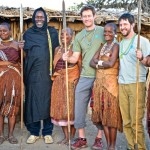Last year we had the incredible opportunity to put on a benefit course in Arusha for Hadza, Datoga and Maasai guides. Our goal was to help them become the primary ambassadors to their own cultures, to improve their skills as guides in order to ensure they increasingly benefit from tourism and introduce their cultures to the world instead of what have typically been outsiders. Building on the success of that course and the excitement of the students, we made plans this year to travel to Lake Eyasi, the last remaining home of the Hadza, to help train more guides of the recently formed Lake Eyasi Cultural Tourism Program. What follows are field notes and photos from SOI Instructor Chris Gibisch.
I struggle to maintain my position in the Land Cruiser as we traveled down the rough dirt road. Shikuku, John, Peter, and I have been on the road for 5 hours, leaving the pavement and once again entering the remote bush country of Tanzania. We are heading south between Lake Manyara and Lake Eyasi into Datoga and Hadzabe territory. We meet up with our contact Momoya near Mang’ola, and continue on to his uncle’s home. A short while later, we step out of the vehicle and into a world that people have only seen through a National Geographic magazine.
Tourism is a booming industry and the effects are being felt all around the world. Even in the most remote of places, the impacts are evident. Tourism in Tanzania is spreading rapidly and companies are looking to expand into new territories, providing the most remote experiences possible. For the Datoga and Hadzabe people, the impact is increasing.
The Datoga are a nomadic pastoralist people derived from Nilotes that moved to the area from Southern Sudan about 3,000 years ago. Living in mud and stick homes, they spread out across the land grazing their cattle and goats. The Hadzabe on the other hand, are hunter-gathers and possibly Earth’s oldest surviving lineage, originating and still living near the Olduvai Gorge, the cradle of mankind. Despite living traditional lifestyles, they have both been affected by western culture, which they are slowly integrating. As the reach of ecotourism has expanded, these two groups have established the Lake Eyasi Cultural Tourism Program to manage its impact. Shikuku, John, Peter, and I are here working with the organization to help the tribes understand this change and how to benefit by guiding tourists.
Momoya has invited us to meet his Datoga family before we make camp. Shikuku and Momoya are old friends so we are getting an authentic invite. In front of us are his uncle’s homes for his large family. They invite us in and Momoya teaches us about the Datoga people. We are sitting on small stools raising only a foot off the ground in a room lit only by the sunlight entering the front door. After an hour or so, we step outside continuing our conversation. In the light of the setting sun, the women have fun dressing us in traditional Datoga garments and jewelry. After many thanks, we part ways and head for our camp and tomorrow’s classroom.



